Always interesting to see facts as opposed to revisionist history...
http://exiledonline.com/reagan%E2%80...rl/#more-28769
http://exiledonline.com/reagan%E2%80...rl/#more-28769
I’ve had Reagan all my life. In 1967, 13 years before the rest of you got President Reagan, he became governor of California. It was the terrarium in which Reagan’s tinkerers figured out how to stimulate the beasts in the tract houses to hatred and bathos, the tools with which they ruled and destroyed the nation.
Nixon usually gets the blame for that, but I’ve always found Nixon a rather sympathetic figure: wretched, ugly, and without much malice for either the forests or the ordinary American. Nixon didn’t even share the worship of “business” forced on us all in Reagan’s reign. Nixon’s dreams were old-fashioned Soviet machinations, full of maps and coups; he was willing enough to toss the rest of us a few bones if we’d let him play with his schemes undisturbed. And some of the bones he tossed us were rather significant. It was Nixon who created the EPA and OSHA. Reagan would have strangled both in the cradle.
Reagan did it often enough once he had power, in a thousand blunt, cruel mandates that no one ever mentions. The one I always remember is one of the more trivial: he vetoed the airbag requirement Carter planned to introduce for all 1980 cars sold in the US. Everyone who died in a head-on crash during the next decade can thank Reagan. And you know, they probably would thank him. There is no end to the groveling masochism of this nation where Reagan is concerned. All his victims love him. No wonder the checkers at Safeway wear nose rings; they belong to the world’s biggest submissive website, “Reagan’s Slaves: Real Submissives, Live 24/7.” Before Reagan they would have had decent blue-collar jobs—there really were such things back then—and bought a house of their own. Now they share garage apartments with the scum of the earth and are saving up for a car that runs.
That’s why it always shocks me when I see another manifestation of the consensus view that Nixon was the evil Republican. I just saw a Futurama episode with Nixon’s head in a jar, planning to take over the world. Reagan never gets that treatment; he’s a god.
I suppose it proves what I knew already: he was good at what he did. After all, if he really was the perfect evil spirit for this tribe, why should I be surprised or disgusted that we worship him? Like I once said to this Women’s Studies professor, “Why get upset at all this sexism? It’s your living; it’s like a marine biologist getting furious at all the salt water on the planet.”
But she was still mad—and she was goddamn well right to be mad. And I’m still sick every time I see headlines like the one I just caught: “Ronald Reagan: How Do GOP Candidates Measure Up?”
The sad thing is, they don’t really have to “measure up.” Reagan transformed this country; that much of what his adorers say is true. His successors only have to hit the same notes to make their zombie army move in the desired manner. Reagan and his stage managers did the difficult part, experimenting relentlessly until they found the notes that worked.
When you say “Reagan,” you’re using a synechdoche of the classic container-for-the-contained sort. Reagan was the face of a little clique who were the essence of California plutocracy. They took shares in him, the way poorer folk do in a racehorse, funded his campaigns, and stayed with him all the way to the presidency. They were remarkable only for their lack of any distinction. Perhaps the most typical was Holmes Tuttle, a car dealer who came from Oklahoma to get rich. He did, but not the way Bill Gates did. Tuttle was so dumb that he turned down a chance to have the first Volkswagen dealership in California because he was sure no American would ever buy a car made by our erstwhile enemies. Like many successful Californians of his generation, he got rich because he was there, on the spot while the population of California exploded, and the average income soared—and because he had the perfect pathology for a rising tide: unreflecting, smug self-confidence. Tuttle made his money in cars, then picked Reagan as his new product and marketed him like a Ford, using Reagan’s front-man status as a selling point: “[Wouldn’t] you rather have a candidate who is backed by very successful capitalists who have created dozens of companies and tens of thousands of jobs, people who know what it takes to attain success within our system?”
Reagan’s other backers were even less distinguished. There was Alfred Bloomingdale, who inherited his money and made the papers in his own right only by buying an underage prostitute, Vicky Morgan, making her his ponygirl, complete with saddle, then dumping her when she was of boring legal age. Bloomingdale died before the palimony suit, but his wife fought to the end not to give the wretched girl a cent. Vicky Morgan was eventually beaten to death with a baseball bat; Bloomingdale was mourned by all of Reagan’s America.
The most grotesque of Reagan’s owners was Joseph Coors, an outright lunatic whose family money is behind nearly every sleazy fascist initiative in recent US history. Coors was Reagan’s mentor on campus radicalism. Coors even had his own hilarious stint on the Board of Regents of the University of Colorado, doing his best to destroy that institution before he realized that it was better to work through the camera-ready Reagan. He made sure Reagan’s hatred of the public universities never let up, but stepped back to let the group refine its techniques for stirring bile among the sullen majority.
It’s tempting sometimes to think what one grenade, detonated at one of this “kitchen cabinet’s” meetings, could have done to change history. California could have been, was on the verge of becoming, something truly extraordinary. It’s no accident that Philip K. Dick’s Martian colonists in their hovels choose to dream of San Francisco in the mid-1960s, out of all the fantasylands they could visit. All the worst of America seemed to be melting away. The South of evil memory: melting away, not without blood and horror, but melting, doomed. The mean, stupid bullies’ world of jocks and losers to which all American children were violently introduced at an early age–melting away in a warmer and more humorous pantheon of possible identities. The dullards’ worship of Coolidge’s “business,” melting away in contemptuous laughter.
It’s easy to see now that this was a delusion, the absurd dream of a tiny fraction of rich kids and middle-class brains. There was another world out there, a thousand times bigger and ferociously devoted to the old hatreds. I grew up in that other world. Actually, I grew up on the border, literally, between those two Californias that Reagan would soon set at each others’ throats: a place called Pleasant Hill, California, 13 miles east of Berkeley, but across the hills, the other side of Caldecott Tunnel. The hot, tract-home side—Reagan’s side. I could cross over; every summer the summer school took us to the Berkeley Folk Festival to listen vaguely to cleaned-up songs about murdered maidens but mainly to look at those magnificent hippie girls, who were in my little mind a complete refutation of the politics, aesthetics and in fact the entire culture of the Reagan side.
But that was once a year. The rest of the time, we were Reaganites before Reagan. You have to realize that in the mid-sixties, what is now called “the Right” was hopelessly confused about what was going on. There really was a sort of silent majority, because no one could figure out to say what it wanted to say in public. What it wanted to say, what I heard every time we watched the news, was simple: “Kill them!” But before Reagan, no one knew how to say that out loud.
It was the students who gave Reagan’s managers their chance. Nobody remembers now how insanely those students were hated by the people out on the hot, sullen side of the California divide. To understand where that hate came from, you have to pan back a little. Reagan’s “Greatest Generation” (which they certainly were not, but that’s another story) created the G.I. Bill, enfranchising a huge number of veterans who would never have dreamed of doing something like going to college if the state hadn’t waved money in their faces while they were being demobilized. In America, higher education had been something for rich kids—rich boys, in the beginning, slowly expanding to include some rich girls as well. Everyone else was supposed to go to work, and count themselves lucky if they found a job.
The G.I. Bill made college a normal option, for a huge chunk of families who weren’t particularly rich. And soon, like many perks that once marked the aristocracy, it became something desirable, then something almost required of those who were striving. My father’s family was one of those. They grew up, ten kids, in a house about the size of your garage in the slums of Jersey City. The war freed them from that claustrophobic Irish-Catholic ghetto and they strove successfully—most of them, anyway. Our failed outpost in the California suburbs was the exception. It wasn’t easy for educated white people to fail completely in California in the post-war years, but we managed it. And still we gave our allegiance to Reagan’s counterrevolution, his long war to destroy the government initiatives that had given all our successful uncles their chance. In fact, our poverty contributed to the virulence of our resentment of those students, those lucky swarms of Berkeley kids who mouthed off and didn’t have to work.
Their world was at once too tempting and too sinful for us, but to most of the other families on our street, it was simply alien, offensive for suggesting that there could or should be a gentler, more literate world. I had a foot in both worlds, and my parents, though fiercely reactionary, were gentle with their children, devoted to our education. So we ended up going to those colleges. But no one else from that neighborhood did. The only way you’ll ever understand how Reagan came to rule is if you actually remember his people. These are some who lived on my street:
My friend Kenny Tamblyn, three houses down: his dad was a welder at the refinery, used to beat Kenny with a belt when he came home in a bad mood. Mr. Tamblyn was pure white and wanted you to know it, too—he was from Oklahoma—but he had these slitty eyes, looked like a cross between a Mongol and an Orc. Liked to shoot things.
The Hansens, up the street with the pickup. Also worked at the refinery, but Mr. Tamblyn didn’t deign to know him; some guild snobbery I never understood. Mr. Hansen was loud and fat and stupid even by local standards. A few years on, he had Wallace signs all over his tiny lawn, but in the mid-60s he settled for threatening to shoot our dog when we walked it past his place. Two sons, roughly my age, sullen, silent, special ed. His wife was rarely allowed out of the house. She was tiny, less than five feet, and I think retarded, with a severe speech impediment. When she escaped and wandered down Belle Avenue, she’d babble about Jesus. (That’s another big, big change since Reagan’s time: it was eccentric, embarrassing, to talk about God in California before Reagan took over.)
The Mastranos at the corner had one son. He was killed in their garage by a DEA agent. Supposedly he was going for a gun. He didn’t own any guns. No one objected; it was clear to everyone that somehow or other he had it coming. His mother went insane.
My brother’s friend Brian, one of the smartest and most delightful little kids I knew. He and my brother met at one of those gifted summer schools. We used to make “civilizations” out of mud and scraps by the creek. But Brian’s dad, who worked at the gas station, would come home pissed off and scream down to the creek, telling Brian to get his butt in there. Once Brian was inside…yeah, you guessed it. With a belt. We tried to walk away fast so we wouldn’t hear Brian screaming.
Brian, IQ or no IQ, was not going to UC Berkeley or anyplace else. None of those kids were going to Berkeley. None of their parents wanted them to. Some of those parents were sick monsters like Brian’s dad, or my friend Calvin’s dad, who once interrupted Calvin’s sleepover birthday party to chase Calvin around the yard with the inevitable belt. Most of the others were just standard human issue: mean, dumb, resentful. They didn’t want the fanciful pre-Raphaelite hippie enclave of Berkeley to exist. That it should not merely exist but talk back to their appointed masters, the real-estate developers and car dealers who were the anointed of California, provoked these people to insane rage.
They weren’t poor. You have to remember that. Reagan would see to it that their kids were poor, but their generation was coasting happily on the well-paid, for-life blue-collar jobs that were plentiful back then. Most of them had far more money than we did, as well as virtually free medical care through “Kaiser.” They were willing to give all that up in the name of what was nearest their hearts: a world in which all public discourse was bland and epideictic, and privilege was restricted to those who were restrained enough to keep it secret. It was the cracking open of American discourse, with the “Free Speech” profanity, people talking about sex, and parading their pleasures on the streets of San Francisco, that made them murderously angry. That rage was even stronger than their hatred of black people. Although Reagan used coded and not-so-coded race triggers in his speeches (“welfare bums” was a favorite of his, as was “militants”), it was the hatred of those students, who were overwhelmingly white and middle-class, that made the people of the inland tracts love him.
And it was that gloating, taunting exhibition of pleasures properly reserved for the back rooms of the elite that drove the inlanders craziest. That was the one thing that made my parents, gentle and erudite people in many ways, make common cause with their neighbors, whom they were in the habit of dismissing as noising, self-indulgent Protestants in most contexts. I’ll always remember my mother’s first day in a writing class at Diablo Valley College, the local community college. She came home in a daze and said, “This woman in my class…one of these hippie women..read her ‘poem’ [you could hear the quotes around the word as she spoke]…and do you know how this ‘poem’ began?”
My brothers and I grunted cautiously. We weren’t sure whose side we were on in this one. In fact, I didn’t come down on the inland side until the local hippie girls made it clear I was not a potential consort.
My mother said, “This is her ‘poem’:
I suppose we were a rather high-strung family. Catholics were, in those days. The only people who remind me of them now are the Muslims.
What cemented my allegiance once and for all to that doomed, absurd code was the fact that somehow in the cornucopia of 1960s California, we were completely bankrupt, utter failures.
Disloyalty was not an option as it was for rich kids. If your parents have made it, you can sneer; when the family narrative is an endless replay of disastrous failure, defecting to the comfy and victorious is unthinkable. My parents voted for Reagan, largely on the strength of that poem and a few news shots of Berkeley women dancing to rock with their tops off. I’m sure everyone on Belle Avenue voted the same way, mostly because Wallace wasn’t running in California yet.
But in their case it made sense. Most of them were brutal and illiterate. We weren’t. We were the kind of family who most needed the public sector Reagan set about destroying: penniless, hyperliterate and ambitious. My brothers and I spent most of our free time at the wonderful library near our house. Last time I checked it was open for about 15 hours a week. We gloried in the art and music classes that were soon to be dropped by the public schools. We loved the forests, the one point we grudgingly shared with the VW Bus crowd that voted liberal. And when I applied for college and was turned down by the expensive private schools, Berkeley, center of Belle Avenue’s hatred, accepted me, gave me a chance for a decent education.
It was the public universities like Berkeley that were Reagan’s special target. He didn’t have any interest in starving Stanford, even if he’d had the power; Stanford was for the rich, and only very belatedly joined the student revolt. It was the public universities, above all the Berkeley campus, that he and his public hated. One of Reagan’s famous lines from the time makes clear the basis of that hate: “Education is a privilege, not a right.” Education, at university level, had always been a “privilege” in the United States. In fact, it was the mark of privilege, a sign of belonging to the upper class. After WW II, that changed, and at least in public universities in a few states like California, there really was something like admission on merit. There was no tuition at public universities—imagine, you could get a degree from UC Berkeley without paying a dollar in tuition, if you were good enough. UC official history page evokes that time with something like disbelief in its timeline: “1960 – The California Master Plan for Higher Education affirmed that UC should remain tuitionfree (a widely held view at the time)…”
Yes, “a widely held view at the time,” but that was going to change, thanks to people like our neighbors on Belle Avenue. They hated the notion that kids no better than their own (or so they believed) were daring to ape the rich by getting respected university degrees—and worse still, they lacked the patronizing discretion of the truly privileged who’d preceded them. The people on my street never resented the really rich. What they hated was middle-class people having pleasure, having sex without punishment, ease without the grasshopper’s winter comeuppance.
Reagan plugged that hate into his owners’ agent and, with an assist from Prop 13, managed to destroy everything that was best about the state: the park system, the libraries, the protected shorelines, forests and rivers. He was just in time; when he took power, coastal California was reaching critical mass. There was a moment, as Hunter Thompson says in Fear and Loathing, when it seemed that whole littoral would just lift up, a reversal of the earthquake the inlanders were praying to sink it, and float away from the dead mass of the continent. Reagan came to fix that.
His method was simple: Reagan was the first to talk straight-out hate. Strange as it seems now, nobody was talking hate then, in public. In the living rooms, over dinner, oh yeah! Every house on our street. But not on the air, not yet. Reagan showed the way. This was Reagan 1.0, the California-only issue. This version had not yet learned his second great innovation: the smile. This early Reagan was angry, as Mark Ames discovered in a search of archived stories from the 1960s. The headlines of those stories would shock fans of the later “amiable” Reagan: “Angry Reagan Shouts Back at Heckling Students”; “Reagan Prepared to Attack Militant Student Leaders”; “Reagan Explains Angry Words.”
Rage at the students not only got Reagan elected, it powered his entire career. He took that show on the road in 1969, delivering a major speech reviling insolent student protestors in DC just before the Vietnam Moratorium demonstrations. As a reporter noted at the time, this was Reagan’s chance to impress the national Republican cadre, which was finally experiencing the sort of student infestation Reagan had been battling for years: “It is an opportunity for [Reagan] to test in a national forum whether his militant stand on California’s campuses…has support among the great middle class nationwide as well as in his own state.”
Of course that’s reporter-speak. They knew by then it would work. If hatred could work in California in the sixties, did anybody really doubt it would work in Missouri? Winning the governorship of California was the hard part, as Nixon found in 1962. From there to the presidency was all downhill for a hate man. All you have to do is start your campaign in Mississippi, as Reagan did in 1979—because in a countrywide election, “blacks” played better than “students.”
There’s another, far stranger, California political story that proves decisively how far you could get by smacking down students: the strange career of S. I. Hayakawa. Until 1968 Hayakawa was an academic wacko, one of those bypassed relics whose office at the end of the corridor is avoided by all. He had pursued a number of bizarre crusades, including one against replacing alphabet prefixes on phone numbers with digits, and by the mid-sixties was marking time, waiting for retirement at the undistinguished CSU-San Francisco. Then his history of rightwing nuttiness lifted him to fame: in 1968 Reagan appointed him president of the university, and a few months later Hayakawa was on the front page of every newspaper in the country, pulling the speaker wires off a student loudspeaker van during a demonstration.
Ten years later Hayakawa was a US senator from California, solely on the strength of that one photo. Belle Avenue had long memories, at least for hate.
Ronald Reagan rose to power much faster. He was sworn in as governor at a few minutes to midnight on January 3, 1967. He was such a hick nutcase that when his astrologer told him that would be the most auspicious moment, Reagan insisted on it, placating the sucker reporters with the usual garbage about wanting to get to work undoing his democrat predecessor’s big-gov’t boondoggles. They all bought it. I never heard a word about Reagan and “his wizened co-star” Nancy’s astrological and UFO creepiness until the late 80s, and no one cared even then.
By that time, Reagan 2.0 had been in power for some time, relying on a lesson learned the hard way during his governorship: use the hate to get in power, but if you want to stay there, you need that Colgate smile they coached you on in Hollywood. This was the smiling Reagan that amnesiac America chooses to recall, the nice grandpa nobody ever had.
But that’s not the Reagan who vivisected my home state. It was his snarl they loved in those days. And even after he learned to smile, the snarl was there, a Cheshire snarl that stayed when the smile faded. Reagan was by that time defined more by a wink than a smile. The wink said to his vast, vile constituency that the smile was simply the best face to wear while the malign enterprise proceeded apace. Like Limbaugh’s little jokes about himself as “a harmless puffball,” Reagan’s smile was meant to be seen through. It was useful for the undecided suckers, because it distinguished him from the other Phalangist contenders, who could not, no matter how long they were coached, stop looking like they were smiling over some hideous memory.
It was a wonderful smile. It suited America right down to the ground: part gloat, part taunt, part utter void. By the time Reagan went to DC, he no longer had to do the grunt work of stoking all that hate. His techniques worked so incredibly well that a whole army of little hate commissars was on the air, all day, every day, keeping Belle Avenue pissed off and stupid. And over all of them presided that terrible smile, at once a taunt, a gloat, and a claim of complete innocence, or at least amnesia.
Nixon usually gets the blame for that, but I’ve always found Nixon a rather sympathetic figure: wretched, ugly, and without much malice for either the forests or the ordinary American. Nixon didn’t even share the worship of “business” forced on us all in Reagan’s reign. Nixon’s dreams were old-fashioned Soviet machinations, full of maps and coups; he was willing enough to toss the rest of us a few bones if we’d let him play with his schemes undisturbed. And some of the bones he tossed us were rather significant. It was Nixon who created the EPA and OSHA. Reagan would have strangled both in the cradle.
Reagan did it often enough once he had power, in a thousand blunt, cruel mandates that no one ever mentions. The one I always remember is one of the more trivial: he vetoed the airbag requirement Carter planned to introduce for all 1980 cars sold in the US. Everyone who died in a head-on crash during the next decade can thank Reagan. And you know, they probably would thank him. There is no end to the groveling masochism of this nation where Reagan is concerned. All his victims love him. No wonder the checkers at Safeway wear nose rings; they belong to the world’s biggest submissive website, “Reagan’s Slaves: Real Submissives, Live 24/7.” Before Reagan they would have had decent blue-collar jobs—there really were such things back then—and bought a house of their own. Now they share garage apartments with the scum of the earth and are saving up for a car that runs.
That’s why it always shocks me when I see another manifestation of the consensus view that Nixon was the evil Republican. I just saw a Futurama episode with Nixon’s head in a jar, planning to take over the world. Reagan never gets that treatment; he’s a god.
I suppose it proves what I knew already: he was good at what he did. After all, if he really was the perfect evil spirit for this tribe, why should I be surprised or disgusted that we worship him? Like I once said to this Women’s Studies professor, “Why get upset at all this sexism? It’s your living; it’s like a marine biologist getting furious at all the salt water on the planet.”
But she was still mad—and she was goddamn well right to be mad. And I’m still sick every time I see headlines like the one I just caught: “Ronald Reagan: How Do GOP Candidates Measure Up?”
The sad thing is, they don’t really have to “measure up.” Reagan transformed this country; that much of what his adorers say is true. His successors only have to hit the same notes to make their zombie army move in the desired manner. Reagan and his stage managers did the difficult part, experimenting relentlessly until they found the notes that worked.
Reagan’s other backers were even less distinguished. There was Alfred Bloomingdale, who inherited his money and made the papers in his own right only by buying an underage prostitute, Vicky Morgan, making her his ponygirl, complete with saddle, then dumping her when she was of boring legal age. Bloomingdale died before the palimony suit, but his wife fought to the end not to give the wretched girl a cent. Vicky Morgan was eventually beaten to death with a baseball bat; Bloomingdale was mourned by all of Reagan’s America.
Bedtime for Bloomingdale’s slave: One day she’s making Reagan look bad (above)… The next day, Jesus pinch-hits one for the Gipper (below)
Then there was Charles Wick, Reagan’s communications guy, the man who taught the Great Communicator how to communicate. Reagan made Wick director of the US Information Agency, but before that, he’d made his bones as a “very successful capitalist” by producing one film: Snow White and the Three Stooges.The most grotesque of Reagan’s owners was Joseph Coors, an outright lunatic whose family money is behind nearly every sleazy fascist initiative in recent US history. Coors was Reagan’s mentor on campus radicalism. Coors even had his own hilarious stint on the Board of Regents of the University of Colorado, doing his best to destroy that institution before he realized that it was better to work through the camera-ready Reagan. He made sure Reagan’s hatred of the public universities never let up, but stepped back to let the group refine its techniques for stirring bile among the sullen majority.
It’s tempting sometimes to think what one grenade, detonated at one of this “kitchen cabinet’s” meetings, could have done to change history. California could have been, was on the verge of becoming, something truly extraordinary. It’s no accident that Philip K. Dick’s Martian colonists in their hovels choose to dream of San Francisco in the mid-1960s, out of all the fantasylands they could visit. All the worst of America seemed to be melting away. The South of evil memory: melting away, not without blood and horror, but melting, doomed. The mean, stupid bullies’ world of jocks and losers to which all American children were violently introduced at an early age–melting away in a warmer and more humorous pantheon of possible identities. The dullards’ worship of Coolidge’s “business,” melting away in contemptuous laughter.
It’s easy to see now that this was a delusion, the absurd dream of a tiny fraction of rich kids and middle-class brains. There was another world out there, a thousand times bigger and ferociously devoted to the old hatreds. I grew up in that other world. Actually, I grew up on the border, literally, between those two Californias that Reagan would soon set at each others’ throats: a place called Pleasant Hill, California, 13 miles east of Berkeley, but across the hills, the other side of Caldecott Tunnel. The hot, tract-home side—Reagan’s side. I could cross over; every summer the summer school took us to the Berkeley Folk Festival to listen vaguely to cleaned-up songs about murdered maidens but mainly to look at those magnificent hippie girls, who were in my little mind a complete refutation of the politics, aesthetics and in fact the entire culture of the Reagan side.
But that was once a year. The rest of the time, we were Reaganites before Reagan. You have to realize that in the mid-sixties, what is now called “the Right” was hopelessly confused about what was going on. There really was a sort of silent majority, because no one could figure out to say what it wanted to say in public. What it wanted to say, what I heard every time we watched the news, was simple: “Kill them!” But before Reagan, no one knew how to say that out loud.
It was the students who gave Reagan’s managers their chance. Nobody remembers now how insanely those students were hated by the people out on the hot, sullen side of the California divide. To understand where that hate came from, you have to pan back a little. Reagan’s “Greatest Generation” (which they certainly were not, but that’s another story) created the G.I. Bill, enfranchising a huge number of veterans who would never have dreamed of doing something like going to college if the state hadn’t waved money in their faces while they were being demobilized. In America, higher education had been something for rich kids—rich boys, in the beginning, slowly expanding to include some rich girls as well. Everyone else was supposed to go to work, and count themselves lucky if they found a job.
The G.I. Bill made college a normal option, for a huge chunk of families who weren’t particularly rich. And soon, like many perks that once marked the aristocracy, it became something desirable, then something almost required of those who were striving. My father’s family was one of those. They grew up, ten kids, in a house about the size of your garage in the slums of Jersey City. The war freed them from that claustrophobic Irish-Catholic ghetto and they strove successfully—most of them, anyway. Our failed outpost in the California suburbs was the exception. It wasn’t easy for educated white people to fail completely in California in the post-war years, but we managed it. And still we gave our allegiance to Reagan’s counterrevolution, his long war to destroy the government initiatives that had given all our successful uncles their chance. In fact, our poverty contributed to the virulence of our resentment of those students, those lucky swarms of Berkeley kids who mouthed off and didn’t have to work.
Their world was at once too tempting and too sinful for us, but to most of the other families on our street, it was simply alien, offensive for suggesting that there could or should be a gentler, more literate world. I had a foot in both worlds, and my parents, though fiercely reactionary, were gentle with their children, devoted to our education. So we ended up going to those colleges. But no one else from that neighborhood did. The only way you’ll ever understand how Reagan came to rule is if you actually remember his people. These are some who lived on my street:
My friend Kenny Tamblyn, three houses down: his dad was a welder at the refinery, used to beat Kenny with a belt when he came home in a bad mood. Mr. Tamblyn was pure white and wanted you to know it, too—he was from Oklahoma—but he had these slitty eyes, looked like a cross between a Mongol and an Orc. Liked to shoot things.
The Hansens, up the street with the pickup. Also worked at the refinery, but Mr. Tamblyn didn’t deign to know him; some guild snobbery I never understood. Mr. Hansen was loud and fat and stupid even by local standards. A few years on, he had Wallace signs all over his tiny lawn, but in the mid-60s he settled for threatening to shoot our dog when we walked it past his place. Two sons, roughly my age, sullen, silent, special ed. His wife was rarely allowed out of the house. She was tiny, less than five feet, and I think retarded, with a severe speech impediment. When she escaped and wandered down Belle Avenue, she’d babble about Jesus. (That’s another big, big change since Reagan’s time: it was eccentric, embarrassing, to talk about God in California before Reagan took over.)
The Mastranos at the corner had one son. He was killed in their garage by a DEA agent. Supposedly he was going for a gun. He didn’t own any guns. No one objected; it was clear to everyone that somehow or other he had it coming. His mother went insane.
My brother’s friend Brian, one of the smartest and most delightful little kids I knew. He and my brother met at one of those gifted summer schools. We used to make “civilizations” out of mud and scraps by the creek. But Brian’s dad, who worked at the gas station, would come home pissed off and scream down to the creek, telling Brian to get his butt in there. Once Brian was inside…yeah, you guessed it. With a belt. We tried to walk away fast so we wouldn’t hear Brian screaming.
Brian, IQ or no IQ, was not going to UC Berkeley or anyplace else. None of those kids were going to Berkeley. None of their parents wanted them to. Some of those parents were sick monsters like Brian’s dad, or my friend Calvin’s dad, who once interrupted Calvin’s sleepover birthday party to chase Calvin around the yard with the inevitable belt. Most of the others were just standard human issue: mean, dumb, resentful. They didn’t want the fanciful pre-Raphaelite hippie enclave of Berkeley to exist. That it should not merely exist but talk back to their appointed masters, the real-estate developers and car dealers who were the anointed of California, provoked these people to insane rage.
They weren’t poor. You have to remember that. Reagan would see to it that their kids were poor, but their generation was coasting happily on the well-paid, for-life blue-collar jobs that were plentiful back then. Most of them had far more money than we did, as well as virtually free medical care through “Kaiser.” They were willing to give all that up in the name of what was nearest their hearts: a world in which all public discourse was bland and epideictic, and privilege was restricted to those who were restrained enough to keep it secret. It was the cracking open of American discourse, with the “Free Speech” profanity, people talking about sex, and parading their pleasures on the streets of San Francisco, that made them murderously angry. That rage was even stronger than their hatred of black people. Although Reagan used coded and not-so-coded race triggers in his speeches (“welfare bums” was a favorite of his, as was “militants”), it was the hatred of those students, who were overwhelmingly white and middle-class, that made the people of the inland tracts love him.
And it was that gloating, taunting exhibition of pleasures properly reserved for the back rooms of the elite that drove the inlanders craziest. That was the one thing that made my parents, gentle and erudite people in many ways, make common cause with their neighbors, whom they were in the habit of dismissing as noising, self-indulgent Protestants in most contexts. I’ll always remember my mother’s first day in a writing class at Diablo Valley College, the local community college. She came home in a daze and said, “This woman in my class…one of these hippie women..read her ‘poem’ [you could hear the quotes around the word as she spoke]…and do you know how this ‘poem’ began?”
My brothers and I grunted cautiously. We weren’t sure whose side we were on in this one. In fact, I didn’t come down on the inland side until the local hippie girls made it clear I was not a potential consort.
My mother said, “This is her ‘poem’:
‘My husband’s ass
Is the most beautiful ass
In the world.’”
Silence reigned in our family room. That word “ass,” spoken—twice!—for the first time inside our house, made us all a little dizzy. You could hear the linebreaks, too, and budding poet that I was, I thought, “Maybe she should’ve put the second ‘ass’ on a line by itself.” Then, in one of the sudden switch-flips you do at 12, I imagined, very vividly, tearing out the tongue of the woman who had recited that poem in front of my mother. My brothers were already running from the room, making “la la la” noises so they wouldn’t have to hear whatever else my mother had experienced in class.Is the most beautiful ass
In the world.’”
I suppose we were a rather high-strung family. Catholics were, in those days. The only people who remind me of them now are the Muslims.
What cemented my allegiance once and for all to that doomed, absurd code was the fact that somehow in the cornucopia of 1960s California, we were completely bankrupt, utter failures.
Disloyalty was not an option as it was for rich kids. If your parents have made it, you can sneer; when the family narrative is an endless replay of disastrous failure, defecting to the comfy and victorious is unthinkable. My parents voted for Reagan, largely on the strength of that poem and a few news shots of Berkeley women dancing to rock with their tops off. I’m sure everyone on Belle Avenue voted the same way, mostly because Wallace wasn’t running in California yet.
But in their case it made sense. Most of them were brutal and illiterate. We weren’t. We were the kind of family who most needed the public sector Reagan set about destroying: penniless, hyperliterate and ambitious. My brothers and I spent most of our free time at the wonderful library near our house. Last time I checked it was open for about 15 hours a week. We gloried in the art and music classes that were soon to be dropped by the public schools. We loved the forests, the one point we grudgingly shared with the VW Bus crowd that voted liberal. And when I applied for college and was turned down by the expensive private schools, Berkeley, center of Belle Avenue’s hatred, accepted me, gave me a chance for a decent education.
It was the public universities like Berkeley that were Reagan’s special target. He didn’t have any interest in starving Stanford, even if he’d had the power; Stanford was for the rich, and only very belatedly joined the student revolt. It was the public universities, above all the Berkeley campus, that he and his public hated. One of Reagan’s famous lines from the time makes clear the basis of that hate: “Education is a privilege, not a right.” Education, at university level, had always been a “privilege” in the United States. In fact, it was the mark of privilege, a sign of belonging to the upper class. After WW II, that changed, and at least in public universities in a few states like California, there really was something like admission on merit. There was no tuition at public universities—imagine, you could get a degree from UC Berkeley without paying a dollar in tuition, if you were good enough. UC official history page evokes that time with something like disbelief in its timeline: “1960 – The California Master Plan for Higher Education affirmed that UC should remain tuitionfree (a widely held view at the time)…”
Yes, “a widely held view at the time,” but that was going to change, thanks to people like our neighbors on Belle Avenue. They hated the notion that kids no better than their own (or so they believed) were daring to ape the rich by getting respected university degrees—and worse still, they lacked the patronizing discretion of the truly privileged who’d preceded them. The people on my street never resented the really rich. What they hated was middle-class people having pleasure, having sex without punishment, ease without the grasshopper’s winter comeuppance.
Reagan plugged that hate into his owners’ agent and, with an assist from Prop 13, managed to destroy everything that was best about the state: the park system, the libraries, the protected shorelines, forests and rivers. He was just in time; when he took power, coastal California was reaching critical mass. There was a moment, as Hunter Thompson says in Fear and Loathing, when it seemed that whole littoral would just lift up, a reversal of the earthquake the inlanders were praying to sink it, and float away from the dead mass of the continent. Reagan came to fix that.
His method was simple: Reagan was the first to talk straight-out hate. Strange as it seems now, nobody was talking hate then, in public. In the living rooms, over dinner, oh yeah! Every house on our street. But not on the air, not yet. Reagan showed the way. This was Reagan 1.0, the California-only issue. This version had not yet learned his second great innovation: the smile. This early Reagan was angry, as Mark Ames discovered in a search of archived stories from the 1960s. The headlines of those stories would shock fans of the later “amiable” Reagan: “Angry Reagan Shouts Back at Heckling Students”; “Reagan Prepared to Attack Militant Student Leaders”; “Reagan Explains Angry Words.”
Rage at the students not only got Reagan elected, it powered his entire career. He took that show on the road in 1969, delivering a major speech reviling insolent student protestors in DC just before the Vietnam Moratorium demonstrations. As a reporter noted at the time, this was Reagan’s chance to impress the national Republican cadre, which was finally experiencing the sort of student infestation Reagan had been battling for years: “It is an opportunity for [Reagan] to test in a national forum whether his militant stand on California’s campuses…has support among the great middle class nationwide as well as in his own state.”
Of course that’s reporter-speak. They knew by then it would work. If hatred could work in California in the sixties, did anybody really doubt it would work in Missouri? Winning the governorship of California was the hard part, as Nixon found in 1962. From there to the presidency was all downhill for a hate man. All you have to do is start your campaign in Mississippi, as Reagan did in 1979—because in a countrywide election, “blacks” played better than “students.”
There’s another, far stranger, California political story that proves decisively how far you could get by smacking down students: the strange career of S. I. Hayakawa. Until 1968 Hayakawa was an academic wacko, one of those bypassed relics whose office at the end of the corridor is avoided by all. He had pursued a number of bizarre crusades, including one against replacing alphabet prefixes on phone numbers with digits, and by the mid-sixties was marking time, waiting for retirement at the undistinguished CSU-San Francisco. Then his history of rightwing nuttiness lifted him to fame: in 1968 Reagan appointed him president of the university, and a few months later Hayakawa was on the front page of every newspaper in the country, pulling the speaker wires off a student loudspeaker van during a demonstration.
Ten years later Hayakawa was a US senator from California, solely on the strength of that one photo. Belle Avenue had long memories, at least for hate.
Ronald Reagan rose to power much faster. He was sworn in as governor at a few minutes to midnight on January 3, 1967. He was such a hick nutcase that when his astrologer told him that would be the most auspicious moment, Reagan insisted on it, placating the sucker reporters with the usual garbage about wanting to get to work undoing his democrat predecessor’s big-gov’t boondoggles. They all bought it. I never heard a word about Reagan and “his wizened co-star” Nancy’s astrological and UFO creepiness until the late 80s, and no one cared even then.
By that time, Reagan 2.0 had been in power for some time, relying on a lesson learned the hard way during his governorship: use the hate to get in power, but if you want to stay there, you need that Colgate smile they coached you on in Hollywood. This was the smiling Reagan that amnesiac America chooses to recall, the nice grandpa nobody ever had.
But that’s not the Reagan who vivisected my home state. It was his snarl they loved in those days. And even after he learned to smile, the snarl was there, a Cheshire snarl that stayed when the smile faded. Reagan was by that time defined more by a wink than a smile. The wink said to his vast, vile constituency that the smile was simply the best face to wear while the malign enterprise proceeded apace. Like Limbaugh’s little jokes about himself as “a harmless puffball,” Reagan’s smile was meant to be seen through. It was useful for the undecided suckers, because it distinguished him from the other Phalangist contenders, who could not, no matter how long they were coached, stop looking like they were smiling over some hideous memory.
It was a wonderful smile. It suited America right down to the ground: part gloat, part taunt, part utter void. By the time Reagan went to DC, he no longer had to do the grunt work of stoking all that hate. His techniques worked so incredibly well that a whole army of little hate commissars was on the air, all day, every day, keeping Belle Avenue pissed off and stupid. And over all of them presided that terrible smile, at once a taunt, a gloat, and a claim of complete innocence, or at least amnesia.
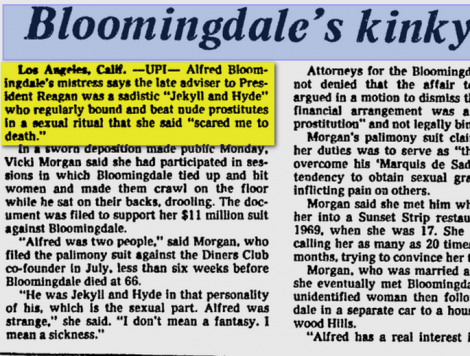
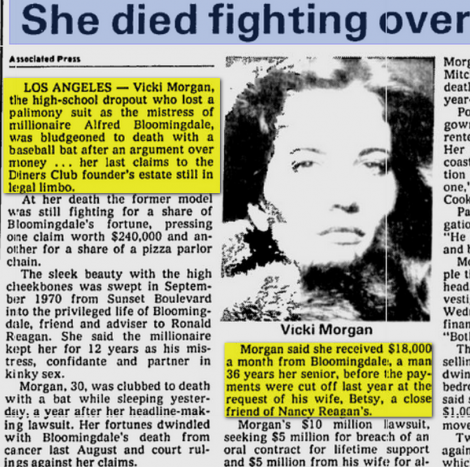
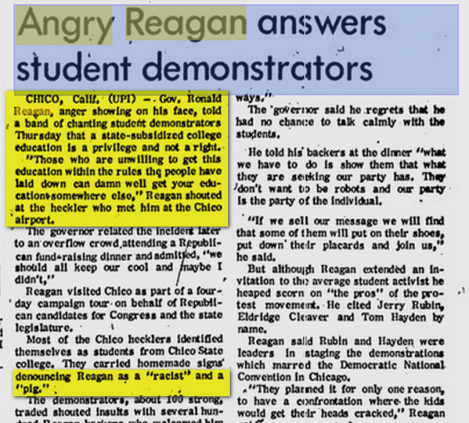
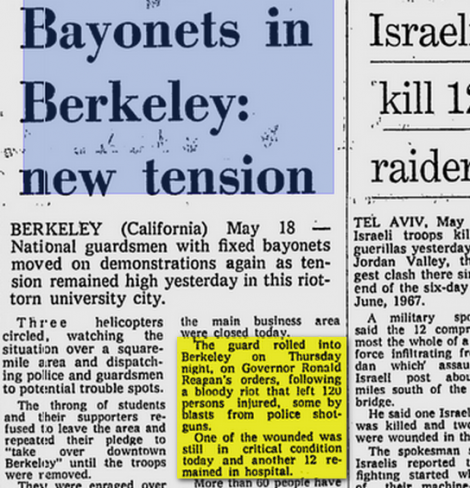
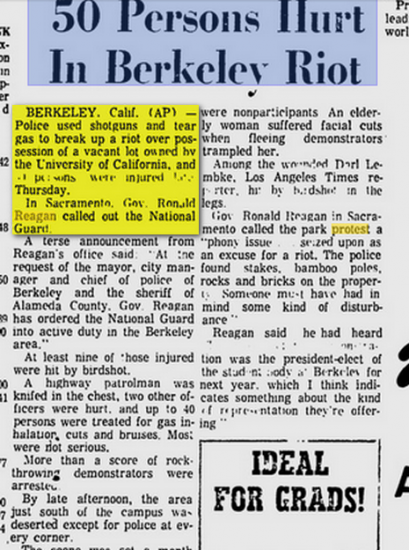
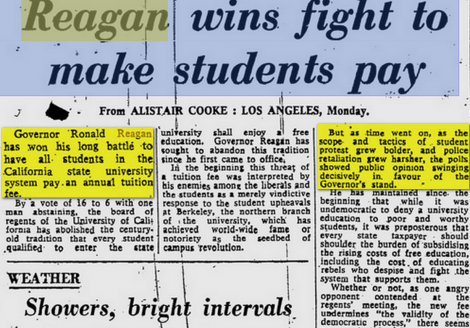
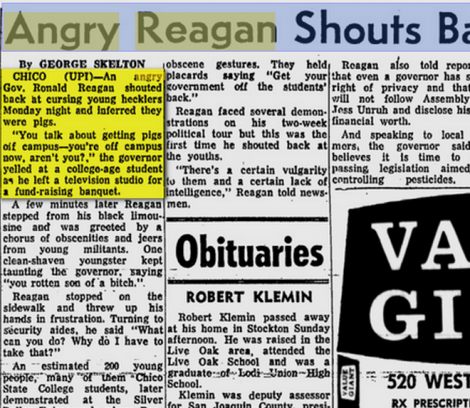
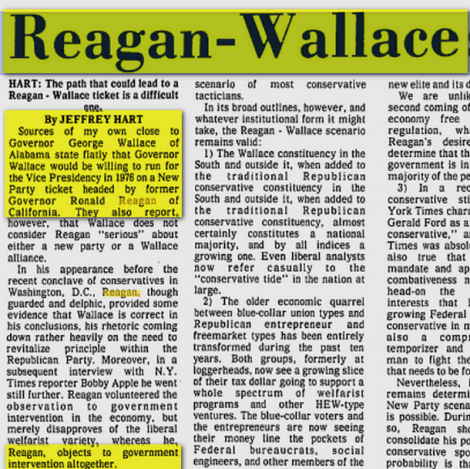
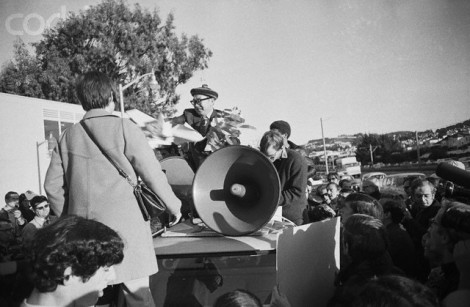

 .
.
Comment